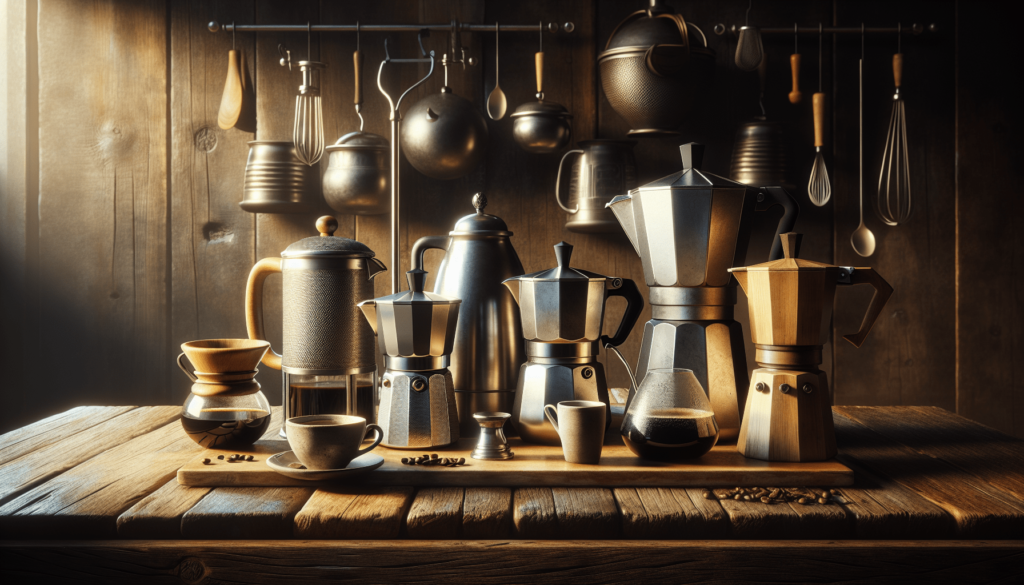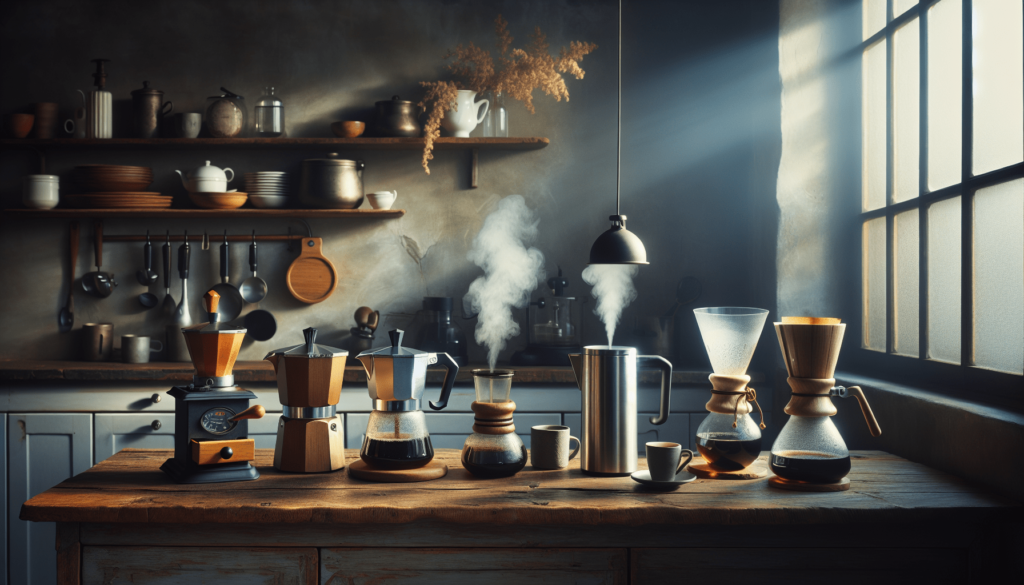Have you ever wondered how many ways there are to brew coffee? The aroma and flavor of coffee can significantly change depending on the brewing method used. With so many techniques at hand, finding the perfect coffee-brewing method might require some experimentation and curiosity.

Understanding Coffee Brewing Basics
Before delving into different brewing techniques, it’s essential to grasp some of the basic principles. Coffee brewing involves extracting flavors from ground coffee beans using water. The process and outcome are influenced by several factors such as grind size, water temperature, and brewing time.
Grind Size
Grind size impacts the extraction rate. Fine grinds extract quicker than coarse grinds. Different brewing methods require different grind sizes, for example, espresso requires a fine grind, while French press necessitates a coarse grind.
Water Temperature
Water temperature can make or break your brew. Generally, the ideal range is between 195-205°F (90-96°C). Too hot, and the coffee will be over-extracted, leading to bitterness. Too cold, and it will be under-extracted, resulting in a flat or sour taste.
Brewing Time
Each brewing method has an optimal time frame for extracting the best flavors from the coffee grounds. Espresso takes around 25-30 seconds, while a slow cold brew might take up to 24 hours.
Traditional Coffee Brewing Methods
There are several established methods known worldwide for their distinct processes and resulting flavors. Let’s dichotomize them into classic and modern methods for simplicity.
Drip Coffee Maker
This is arguably the most common and convenient method, especially in American households.
- Grind Size: Medium
- Water Temperature: 200°F (93°C)
- Brewing Time: 5-10 minutes
French Press
The French Press or Press Pot method produces a rich, full-bodied cup by immersing coarsely ground coffee in water.
- Grind Size: Coarse
- Water Temperature: 200°F (93°C)
- Brewing Time: 4 minutes
Espresso Machine
Espresso machines use pressure to force hot water through finely-ground coffee, producing a concentrated and robust shot of coffee.
- Grind Size: Fine
- Water Temperature: 190°F (88°C)
- Brewing Time: 25-30 seconds
| Coffee Method | Grind Size | Water Temperature | Brewing Time |
|---|---|---|---|
| Drip Coffee | Medium | 200°F (93°C) | 5-10 minutes |
| French Press | Coarse | 200°F (93°C) | 4 minutes |
| Espresso | Fine | 190°F (88°C) | 25-30 seconds |
Contemporary Coffee Brewing Techniques
Newer methods of brewing have also carved their niches and offer unique twists on the conventional coffee experience.
AeroPress
AeroPress offers a quick and versatile way to brew coffee, working almost like a hybrid between French press and espresso.
- Grind Size: Medium-fine
- Water Temperature: 175-185°F (80-85°C)
- Brewing Time: 1-2 minutes
Chemex
Known for its elegant design, Chemex employs a thicker paper filter, resulting in a clean cup with a distinct taste.
- Grind Size: Medium-coarse
- Water Temperature: 200°F (93°C)
- Brewing Time: 4-5 minutes
Moka Pot
This stovetop method creates a strong, espresso-like coffee without needing a complex machine.
- Grind Size: Fine
- Water Temperature: N/A (uses boiling water)
- Brewing Time: 5 minutes
| Coffee Method | Grind Size | Water Temperature | Brewing Time |
|---|---|---|---|
| AeroPress | Medium-fine | 175-185°F (80-85°C) | 1-2 minutes |
| Chemex | Medium-coarse | 200°F (93°C) | 4-5 minutes |
| Moka Pot | Fine | N/A (uses boiling water) | 5 minutes |
Cold Brewing Methods
Cold brewing methods are perfect for those who prefer their coffee chilled, smooth, and less acidic.
Cold Brew
Cold brew involves steeping coarsely ground coffee in cold water for an extended period.
- Grind Size: Coarse
- Water Temperature: Cold
- Brewing Time: 12-24 hours
Japanese Iced Coffee
Japanese Iced Coffee quickly brews hot coffee directly onto ice, preserving the nuanced flavors.
- Grind Size: Medium
- Water Temperature: 200°F (93°C)
- Brewing Time: 3-4 minutes
| Coffee Method | Grind Size | Water Temperature | Brewing Time |
|---|---|---|---|
| Cold Brew | Coarse | Cold | 12-24 hours |
| Japanese Iced Coffee | Medium | 200°F (93°C) | 3-4 minutes |

Specialty Coffee Brewing Techniques
For those looking to take their coffee making to an artisanal level, several specialty methods can elevate your coffee game.
Siphon Coffee
Siphon coffee makers use vapor pressure and vacuum to brew coffee, resulting in a light and aromatic cup.
- Grind Size: Medium
- Water Temperature: 200°F (93°C)
- Brewing Time: 6-7 minutes
Turkish Coffee
A method that dates back centuries, Turkish coffee is brewed by simmering extra finely ground coffee and water in a special pot called a cezve.
- Grind Size: Extra-fine
- Water Temperature: N/A (escapes boiling)
- Brewing Time: 2-3 minutes
Pour Over
The pour-over method allows for meticulous control over water pour, enabling you to extract the full range of flavors from the coffee.
- Grind Size: Medium-coarse
- Water Temperature: 200°F (93°C)
- Brewing Time: 3-4 minutes
| Coffee Method | Grind Size | Water Temperature | Brewing Time |
|---|---|---|---|
| Siphon Coffee | Medium | 200°F (93°C) | 6-7 minutes |
| Turkish Coffee | Extra-fine | N/A (escapes boiling) | 2-3 minutes |
| Pour Over | Medium-coarse | 200°F (93°C) | 3-4 minutes |
Key Takeaways on Brewing Methods
Choosing the right brewing method depends on your taste preferences, available time, and the equipment at your disposal. Each method brings out different aspects of the coffee bean, from a bright and acidic cup to a rich and full-bodied brew.
Experiment to Find Your Ideal Brew
Experimenting with different methods is part of the fun in discovering your ideal coffee. Try varying the grind size, brewing time, and water temperature to see how each factor changes the final flavor profile.
Quality of Coffee Beans
Always prioritize the quality of your coffee beans. Freshly roasted beans ground just before brewing tend to yield the best results, irrespective of the brewing method.
Water Quality
Don’t overlook water quality. Since coffee is mostly water, using filtered water can make a significant difference in taste.
Conclusion
Brewing coffee is as much an art as it is a science. Whether you prefer the simplicity of a drip coffee maker or the precision of a pour-over, each method has its unique charm and can offer a delightful coffee experience. Embrace the diversity of brewing techniques to explore the myriad of flavors and aromas that coffee has to offer. Enjoy the journey as you find your perfect cup.
